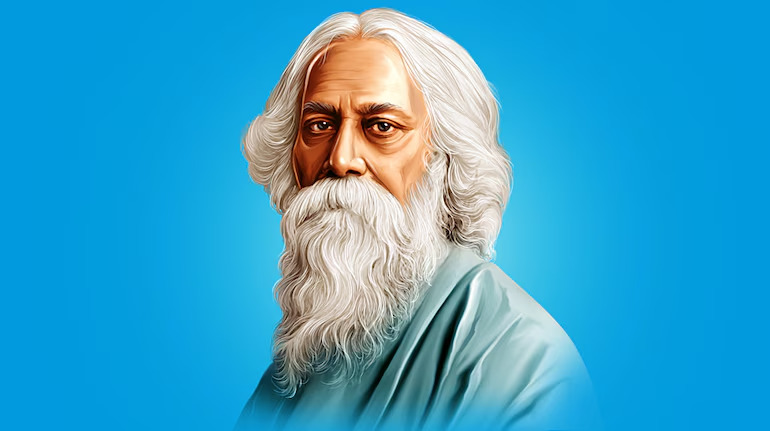Table of Contents
ToggleTop 10 Unknown and Interesting Facts about Rabindranath Tagore
Rabindranath Tagore was a polymath who was born in Kolkata, India, on May 7, 1861. His contributions to music, writing, and education have had a lasting impact on society. Often referred to as the “Bard of Bengal,” he was the first non-European to win the Nobel Prize in Literature in 1913 for his thought-provoking poetry book Gitanjali.
Poems, songs, and essays, among other publications of Tagore, demonstrate his strong affinity for humanism, spirituality, and the natural world. His writings promoted compassion, love, and the pursuit of inner serenity regardless of genre or subject matter. The creation of Jana Gana Mana, the national song of India, and Amar Shonar Bangla, the national anthem of Bangladesh, solidified Tagore’s reputation throughout the subcontinent.

Beyond the realm of literature, Tagore was a trailblazing teacher who established Santiniketan’s Visva-Bharati University by fusing conventional Indian education with cutting-edge teaching methods. In addition, he was an outspoken opponent of British colonialism and supported peaceful methods of achieving India’s independence.
This article delves into 10 unknown and interesting facts about Rabindranath Tagore that will give you a deeper understanding of this Nobel Laureate and Renaissance man.
1. The First Non-European Nobel Laureate
As the first non-European to win the Nobel Prize in Literature in 1913 for his collection of poems “Gitanjali” (Song Offerings), Rabindranath Tagore created history. Many people are unaware that Tagore’s Nobel Prize marked a sea change for Indian literature overall as well as for him personally. He gave the international literary world a voice that was distinctly Indian.
His profound spirituality and distinctive fusion of contemporary and conservative ideals struck a chord with Westerners, especially during India’s colonial era. By receiving the prize, Tagore demonstrated that intelligence and art were not constrained by political or geographic boundaries and opened the door for non-Western literature to be recognized on a worldwide scale.
2. He Was Given the Knighthood Title, but He Rejected the Title
Rabindranath Tagore received a knighthood by the British Empire in 1915 in recognition of his literary and artistic achievements. But Tagore surrendered his knighthood in protest after the 1919 Jallianwala Bagh Massacre, in which hundreds of Indian villagers, unarmed, were massacred by British forces. This action was not only symbolic, but it also demonstrated his strong belief in equality, justice, and the struggle against colonial oppression. “The time has come when badges of honour make our shame glaring in their incongruous context of humiliation,” Tagore said in a letter to the Viceroy.
This act of rebellion solidified his reputation as a moral person who upheld human rights and dignity, in addition to his status as a literary genius.
3. A Prolific Painter Who Started Late
Though his words are what made Rabindranath Tagore famous, many people are unaware of his skill as a painter. Even more intriguing is the fact that he was a latecomer to the visual arts, having just begun painting in his 60s. On the other hand, his paintings were avant-garde and distinctive, frequently defying accepted conventions in modern Indian art.
Tagore’s poetic and philosophical concepts had a close relationship with his artwork. Over 2,000 works of art were produced by him during his lifetime. His paintings were praised for their fusion of modernist abstraction with Eastern mysticism when they were shown all across Europe, particularly in France and England. He concentrated mostly on human figures, birds, and mythological motifs in his brushstrokes, which were regarded as bold, abstract, and enigmatic.
4. He Composed the National Anthems of Two Countries
The unique distinction of having written the national anthems of Bangladesh and India belongs to Rabindranath Tagore.
Tagore wrote “Jana Gana Mana,” the national anthem of India, in Bengali in 1911. In 1950, India became an independent republic and adopted it as its national anthem.
Similar to this, during Bangladesh’s independence movement in 1971, Tagore’s song “Amar Shonar Bangla” was adopted as the nation’s anthem.
His profound affinity for the people, land, and culture of Bengal and beyond is evident in both songs, underscoring his dual function as a transnational cultural bridge builder and national poet.
5. He Founded the World Famous Visva-Bharati University
The educational ideas of Rabindranath Tagore were far ahead of their time. He thought that the rigorous educational environment and current rote memorizing system inhibited creativity. He established Visva-Bharati University in Santiniketan, West Bengal, in 1921 in an effort to effect reform. His goal was to provide an environment where learning took place outside of traditional classroom walls and allowed children to interact holistically with literature, art, music, and the natural world.
Global philosophers, artists, and scholars flocked to the university. It was intended to be a worldwide hub for education, a place where the East and the West might interact. As a tribute to Tagore’s progressive educational philosophy, Visva-Bharati continues to this day, harmoniously fusing the best aspects of Western and Indian traditions.
6. Traveled All Over the World, Had Extensive Travel Experiences
Rabindranath Tagore was a world traveler who saw a great deal of the Americas, Europe, and Asia. He was not limited to the subcontinent. His travels were not just personal quests but also educational and cultural exchange trips. He traveled to the United States, Argentina, China, Japan, England, and other countries where he met and conversed with various thinkers, authors, and political figures.
His travels had a profound impact on his worldview, and he frequently discussed the necessity of intercultural harmony and collaboration. He developed become an advocate for India’s cultural and spiritual identity while also promoting world citizenship. During these journeys, he wrote and gave talks that had a significant role in exposing Indian ideas to the West, particularly in literary and academic circles.

7. An Early Advocate of Feminism
Rabindranath Tagore was a fervent supporter of women’s rights even though he lived in an era when women in India were subject to severe social constraints. In contrast to the conventional portrayals of women in Indian literature, his works frequently featured strong, autonomous female protagonists.
In works like “Chokher Bali,” “Ghare Baire” (The Home and the World), and “Char Adhyay,” Tagore portrayed female characters in a way that subverted patriarchal systems and social standards. He thought that women ought to have equal access to education and that emancipating them was essential to society’s advancement.
Tagore’s efforts to educate women at Visva-Bharati and his insistence on establishing spaces where women could express themselves creatively were further indications of his progressive ideas on gender equality.
8. Love for Nature
Not only do Tagore’s poetry capture his profound relationship with nature, but his whole way of life does as well. He thought that education shouldn’t be limited to the four walls of a classroom and that people should live in harmony with the natural world. This idea served as the foundation for his Santiniketan school, where students learned outside in classrooms beneath trees.
Nature is a major theme in several of his poetry and songs, particularly in “Gitanjali,” where it represents divinity, liberation, and tranquility. He considered nature as a spiritual force that could uplift the spirit and stimulate creativity, which is why he was so enthralled with it beyond its aesthetic value.
9. A Pioneer in Rural Development
In addition to being a poet and philosopher, Rabindranath Tagore was a social reformer with a strong affinity for rural India. He thought that the development of India’s villages was the only path to growth. He launched a number of rural development initiatives in Sriniketan, a section of the Visva-Bharati campus, in order to carry out this vision.
In an effort to make villages self-sufficient, Tagore developed advanced farming techniques, supported cottage industries, and pushed rural education. His work served as a model for other rural development programs that the Indian government eventually embraced.
10. The Hidden Relationship with Einstein
A little-known but intriguing truth about Rabindranath Tagore is that he had a deep intellectual conversation with the renowned physicist Albert Einstein. When the two first met in Berlin in 1930, they had an influential discussion regarding the nature of truth, reality, and the interplay of spirituality and science.
Whereas Einstein addressed the discussion from a scientific, materialistic perspective, Tagore’s ideas were firmly grounded in Indian philosophy and spirituality. Notwithstanding their divergent viewpoints, the two esteemed thinkers harbored a profound regard for one another.
The conversations between Tagore and Einstein demonstrate the universality of Tagore’s thinking and his openness to discussing innovative scientific concepts, which help to close the gap between science and the humanities.
Conclusion: The life of Rabindranath Tagore was a unique tapestry of philosophy, education, social reform, poetry, and art. His impact on India and the global community extends beyond his well-known literary and musical compositions. These ten little-known facts about him highlight the complexity of his personality and his creative genius, which still inspires millions of people worldwide. Tagore is still revered today as a towering person whose legacy lives on as the first Asian Nobel Laureate, a poet who brought nations together through song, and a knight who gave up his title.

